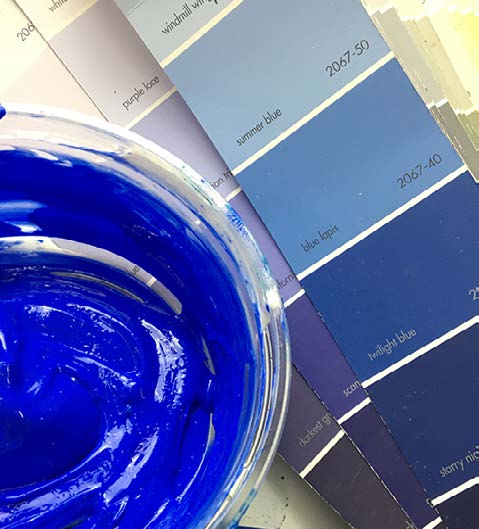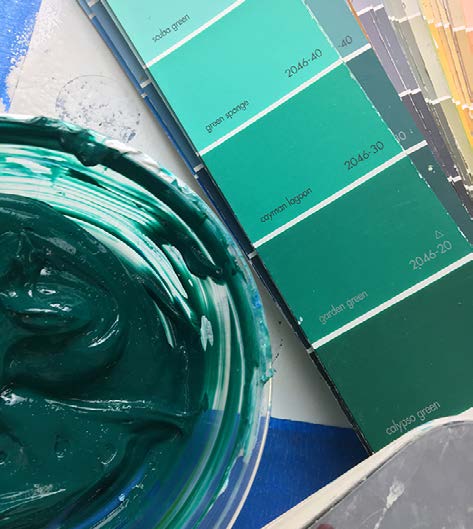

DECORATIVE FINISH HOW-TO
Blue Marble Finish
Artist: Arteriors
Share this article
PROJECT SUPPLIES:
- Golden Paintworks Glazing Gel
- Golden Paintworks Glazing Medium
- Golden Paintworks Slow Dry Fluid Acrylics: Carbon Black, Phthalo Green (Yellow Shade, Phthalo Blue (Green Shade), and Ultramarine Blue
- Golden Paintworks Pre-Mixed Metallic Paint: Pewter
- Golden Paintworks Metallic Paint: Tint Base Pearl
- Bonding Primer
- White Paint, Satin Sheen
- Benjamin Moore Rocky Mountain Sky 2066-40, Matte Sheen
- Paint Brushes
- Mixing Containers
- Sea Sponge
- Blow Dryer
- Polka Dot Stencil
- Low Tack Painter’s Tape
- Stencil Brush or Upholstery Foam Pieces
- Cotton Rags
INSTRUCTIONS:
Introduction: Blue Marble Finish is a decorative homage to Planet Earth, one that appears like a blue marble from outer space. This finish is a lot like lasagna; there are lots of steps, and if you follow them well you can’t go wrong. And who doesn’t like polka dots or blue marbles?
1 | Prep, prime, and apply a solid coat of Benjamin Moore Rocky Mountain Sky 2066-40 in a matte sheen. Allow to dry completely.
(Photo 1)
2 | Mix one part Glazing Medium with one part Slow Dry Fluid Acrylic Carbon Black. Add a little water and mix so that it is the consistency of whole milk. Paint over the Rocky Mountain Sky base in loose brush strokes, leaving lots of open spaces. Subtract the black glaze with a damp sea sponge by tapping over the wet paint and “smooshing” it into open areas, leaving an organic black and blue broken surface. Let dry. Use a blow dryer to speed up the drying process.
(Photos 2-3)
3 | Using the same subtractive technique as in Step 2, apply Pre-Mixed Metallic Paint Pewter over the blue and black finish. Water down the metallic paint a little so that it is the same consistency as half and half cream. Allow to dry, using a blow dryer to speed up the drying process. Repeat this step using the same metallic paint, or if you would like a lighter background use the Metallic Paint Tint Base Pearl. Allow the background to dry thoroughly, preferably 12 hours.
(Photos 4-6)
4 | Create your own stencil from mylar, which can be found in art stores, or purchase a polka dot pattern from a stencil company. The one we are using is a low-tack adhesive stencil. Apply the stencil to the surface, following instructions from the stencil company. If this will be an all-over stencil covering entire walls, we suggest using stencils specifically for all-over applications that have registration marks so that pattern can be repeated seamlessly over the entire surface. After the stencil is adhered, use a damp but wrung out upholstery foam to apply satin white paint in a mottled way, and not completely solid. Let dry.
(Photos 7-8)
6 | Using the three color gels, apply with flat sections of upholstery foam, or with a stencil brush over the stencil. Dab the loaded foam or stencil brush on a paper towel before stenciling so the paint goes on the surface fairly dry. Create an ombre effect by blending bands of the three colors together. Keep these colors wet for the next step.
(Photo 13)
7 | While these colors are still wet, use a damp sea sponge to pounce and twist over the stenciled dots, subtracting bits of color, and revealing some of the original dark and white undercoat.
(Photo 14)
8 | Once the blue and green paint layers dry, remove
the stencil.
(Photo 15)
9 | OPTIONAL: Repeat Step 2 over the stenciled dots and background, but reduce the coverage by approximately half. While this layer is still wet, wrap a couple layers of a damp cotton rag around your index finger and wipe off the centers of the dots, moving the rag to a clean section every two or three dots.
(Photos 16–18)
Featured Products
About the Artists
Amiel and Stephanie Mesner are a husband-and-wife team of fine artists who turned their love and knowledge of the fine and decorative arts into a company with over thirty-five years of experience, creating custom surface designs for the architectural and interior design industry. Arteriors, based in Natick, MA, handles professional design projects from idea and design creation through to finished application in a versatile, detail-oriented, expert manner. Dedicated to using eco-friendly decorative paint and plaster materials that are not only beautiful when applied, but responsible, Arteriors applies water-based paints and lime-based plasters, such as Venetian plasters, and American clay surface finishes which are safe, natural, and sustainable and can improve indoor air quality.
More from this artist
Looking for more inspiration? Click here to view all of the decorative finishes from our Limited Edition Collections.























